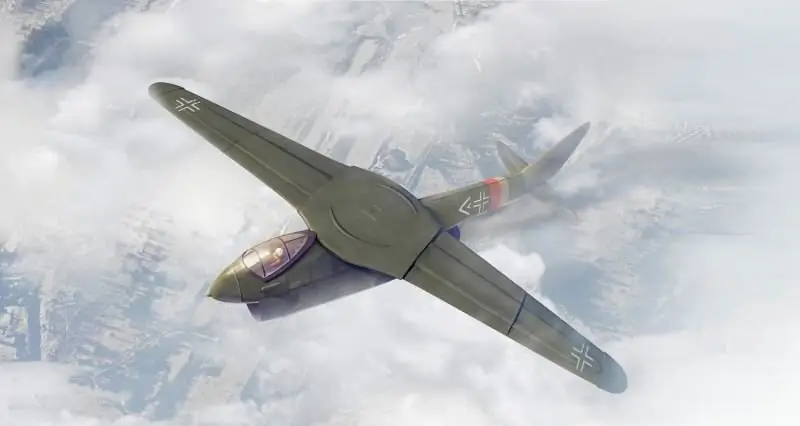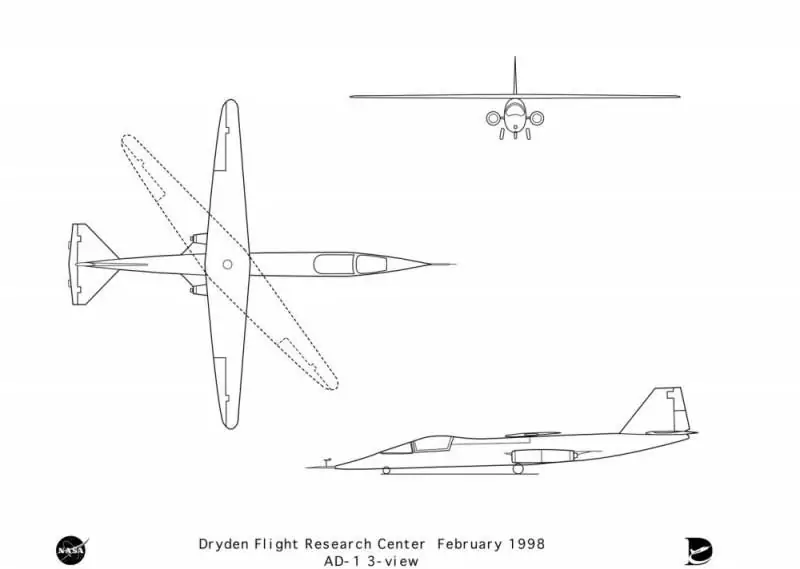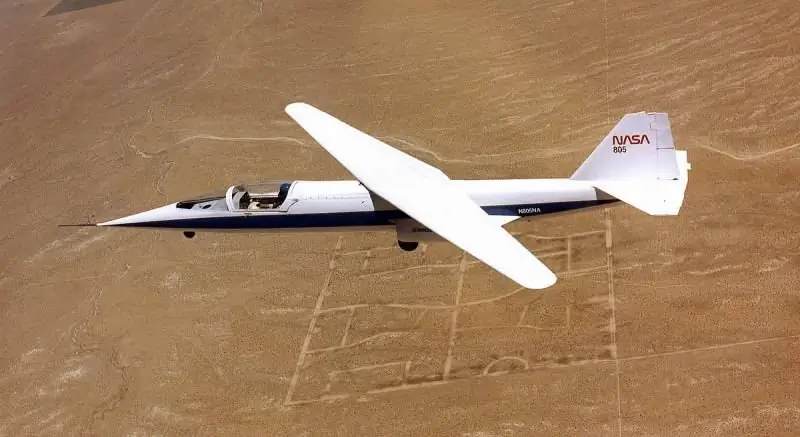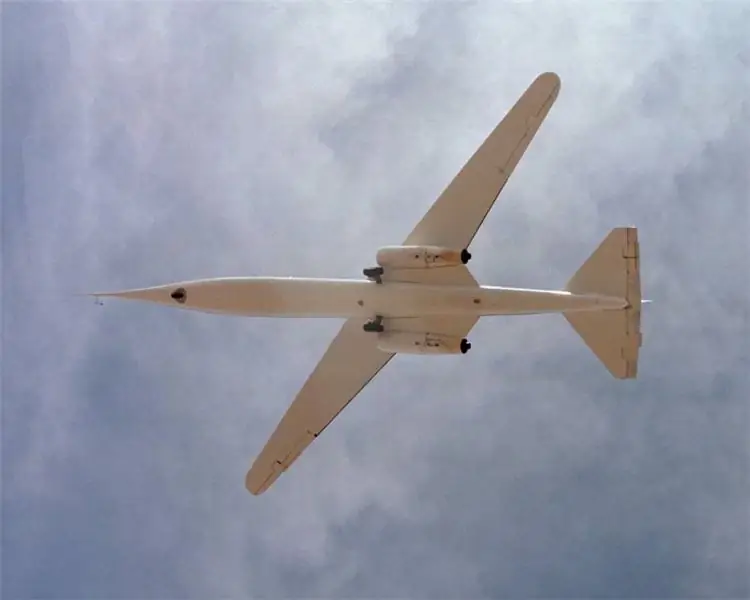- Author Matthew Elmers [email protected].
- Public 2024-01-11 04:35.
- Last modified 2025-01-24 09:17.
Even the most unusual airplanes were built according to the principles of symmetry at the dawn of the aircraft industry. Any aircraft had a conventional fuselage, to which conventional wings were attached perpendicularly. However, gradually, with the development of aerodynamics, designers began to think about creating an aircraft with an asymmetric wing. Representatives of the gloomy German genius were the first to reach this: in 1944, a similar project was proposed by Richard Vogt, chief designer of Blohm & Voss. However, his project was not embodied in metal; the American NASA AD-1 was truly the first aircraft with a rotary wing.
NASA AD-1 (Ames Dryden-1) is an experimental aircraft designed to study the concept of an asymmetrically variable sweep rotary wing. Became the world's first oblique wing aircraft. The unusual aircraft was built in the United States in 1979 and made its first flight on December 21 of the same year. Tests of the aircraft with a rotary wing continued until August 1982, during which time 17 pilots managed to master the AD-1. After the closure of the program, the plane was sent to the Museum of the City of San Carlos, where it is still available to all visitors and is one of the most important exhibits on display.
German experiments
In Germany, during the Second World War, they worked quite seriously on the creation of aircraft with an asymmetric wing. Designer Richard Vogt was famous for his atypical approach to the creation of aviation technology, he understood that the new scheme would not prevent the aircraft from being stable in the air. In 1944 he created the Blohm & Voss and P.202 aircraft project. The main idea of the German designer was the possibility of a significant reduction in drag when flying at high speed. The aircraft took off with a conventional symmetrical wing, since a small swept wing had a high coefficient of lift, but already during flight, the wing turned in a plane parallel to the fuselage axis, reducing the level of resistance. At the same time, work was carried out in Germany with the classic symmetrical sweep of the wing on the Messerschmitt P.1101 fighter.

Blohm & Voss and P.202
But even in Germany in the last war years, the Blohm & Voss and P.202 project seemed insane, it was never embodied in metal, forever remaining only in the form of blueprints. The aircraft designed by Vogt was supposed to receive a wing with a span of 11.98 meters, which rotated on the central hinge at an angle of up to 35 degrees - with a maximum deviation, the wingspan changed to 10.06 meters. The main disadvantage of the project was considered to be a heavy and cumbersome (according to calculations) mechanism for turning the wing, which took up a lot of space inside the aircraft fuselage, and the inability to use the wing for suspension of additional weapons and equipment was also a serious disadvantage.
Surprisingly, Vogt was not the only German designer who thought about the swing wing. A similar project was prepared by engineers at Messerschmitt. The Me P.1109 project presented by them even received the nickname "scissor wing". The project they created had two wings at once. Moreover, they were independent from each other. One wing was above the fuselage of the aircraft, the other was below it. When the upper wing turned clockwise, the lower wing turned in the same way, but counterclockwise. This design made it possible to qualitatively compensate for the skew of the aircraft with an asymmetric change in sweep. At the same time, the wings could turn at an angle of up to 60 degrees, while when they were located perpendicular to the aircraft fuselage, it was no different from the classic biplane. In doing so, Messerschmitt faced the same problems as Blohm & Voss: a very complex turning mechanism. Despite the fact that none of the German asymmetric aircraft did not go beyond paper projects, it should be admitted that the Germans were seriously ahead of their time in their development. The Americans were able to realize their plan only in the late 1970s.
NASA AD-1 - flying asymmetry
The ideas of the German designers were implemented in metal by their American colleagues. They approached the issue as thoroughly as possible. Independently of the Germans in 1945, the American engineer Robert Thomas Johnson put forward his idea of a kind of "scissor wing", according to his idea, such a wing had to rotate on a special hinge. However, in those years he could not realize his idea, technical capabilities did not allow. This changed in the 1970s when technology made the creation of asymmetrical aircraft possible. At the same time, the same Richard Vogt, who emigrated to the United States after the end of World War II, was invited as a project consultant.

By that time, the designers already knew that aircraft with variable sweep wings had a number of disadvantages. The main disadvantages of this design included: the shift of the aerodynamic focus when changing sweep, which led to an increase in balancing resistance; an increase in the mass of the structure due to the presence of a load-bearing beam and pivot hinges of the consoles attached to it, as well as seals of the retracted position of the aircraft wing. Both of these shortcomings were ultimately the reason for a decrease in the flight range or a decrease in the mass of the payload.
At the same time, NASA employees were confident that an aircraft with an asymmetrically variable sweep wing (KAIS) would be deprived of the listed disadvantages. With such a scheme, the wing would be attached to the aircraft fuselage using one pivot hinge, and the change in the sweep of the consoles when the wing was rotated would be performed simultaneously, but had the opposite character. A comparative analysis of aircraft with a variable sweep wing of the standard scheme and KAIS carried out by NASA specialists showed that the second scheme shows a decrease in drag by 11-20 percent, the mass of the structure decreases by 14 percent, and the wave drag when flying at supersonic speeds should decrease by 26 percent. …
At the same time, the aircraft with an asymmetric wing had its drawbacks. First of all, with a large sweep angle, a straight swept cantilever has a larger effective angle of attack than a reverse swept cantilever, which leads to an asymmetry of the drag and, as a consequence, to the appearance of parasitic turning moments in pitch, roll and yaw. The second problem was that KAIS is characterized by a twice as large increase in the thickness of the boundary layer along the wing span, and any asymmetric stall of the flow provokes intense disturbances. But, despite this, it was believed that negative effects could be eliminated by introducing a fly-by-wire control system, which would automatically affect the aerodynamic controls of the aircraft, depending on various parameters: angle of attack, flight speed, wing sweep angle. In any case, to check all the calculations, it was necessary to build a flying model.

The KAIS concept was successfully tested on an unmanned model, after which it was necessary to move on to creating a full-fledged aircraft. The experimental project was designated NASA AD-1 or Ames Dryden-1. The aircraft was named after the research centers that worked on the project - NASA Ames and NASA Dryden. At the same time, Boeing specialists were responsible for the overall design of the aircraft. According to the calculations of NASA engineers and the available terms of reference, the American company Rutan Aircraft Factory assembled the required aircraft. At the same time, one of the requirements of the project was to keep within the budget of 250 thousand dollars. For this, the experimental aircraft was made as simple as possible in terms of technology and cheap; rather weak engines were installed on the aircraft. The new aircraft was ready in February 1979, after which it was delivered to California at NASA's Dryden airfield.
The wing of the AD-1 experimental aircraft could rotate along the central axis by 60 degrees, but only counterclockwise (this solution significantly simplified the design without losing its advantages). The wing turn at a speed of 3 degrees per second was provided by a compact electric motor, which was installed inside the aircraft fuselage directly in front of the main engines. As the latter, two classic French-made Microturbo TRS18 turbojet engines with a thrust of 100 kgf each were used. The span of the trapezoidal wing, when positioned perpendicular to the fuselage, was 9, 85 meters, and at maximum turn - only 4, 93 meters. At the same time, the maximum flight speed did not exceed 400 km / h.
The plane first took to the skies on December 21, 1979. On its maiden flight, it was flown by NASA test pilot Thomas McMurphy. The takeoff of the aircraft was carried out with a perpendicularly fixed wing, the angle of rotation of the wing changed already in flight after reaching the required speed and altitude. Over the next 18 months, with each new test flight, the wing of the AD-1 aircraft was rotated 1 degree, while recording all flight indicators. As a result, in mid-1980, the experimental aircraft reached its maximum wing angle of 60 degrees. Test flights continued until August 1982, in total the aircraft took to the sky 79 times. It so happened that on the last flight on August 7, 1982, the plane was lifted by Thomas McMurphy, while 17 different pilots flew on it during the entire test period.

The test program assumed that the results obtained would help to use the asymmetric change in sweep of the wing when performing long intercontinental flights - the speed and fuel economy should have paid off in the best way at very long distances. The experimental NASA AD-1 aircraft received positive reviews from pilots and specialists, but the project did not receive further development. The problem was that the program was originally viewed as a research program. Having received all the necessary data, NASA simply sent a unique aircraft to the hangar, from where it was later transferred to the aviation museum. NASA has always been a research organization that has not dealt with aircraft construction, and none of the largest aircraft manufacturers were interested in the concept of a rotating wing. Any intercontinental passenger liner was by default more complex and larger than the "toy" AD-1 aircraft, so the companies did not risk it. They did not want to invest in research and development, albeit a promising, but still suspicious design. The time for innovation in this area, in their opinion, has not yet come.
Flight performance of NASA AD-1:
Overall dimensions: length - 11, 8 m, height - 2, 06 m, wingspan - 9, 85 m, wing area - 8, 6 m2.
Empty weight - 658 kg.
Maximum takeoff weight - 973 kg.
The power plant is 2 turbojet engines Microturbo TRS18-046 with a thrust of 2x100 kgf.
Cruising speed - 274 km / h.
The maximum speed is up to 400 km / h.
Crew - 1 person.






